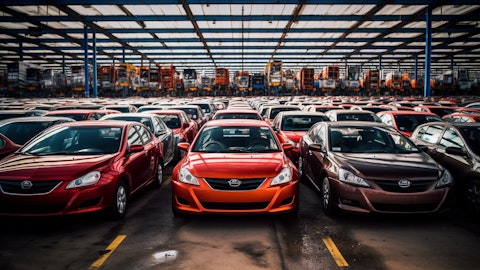So I think I mentioned, we reduced payroll — salary payroll last year over 10% by delayering, by consolidating, by making the organization operate more efficiently, that’s something we’ll continue to do. Typically, this is a business where you see margin expansion from first half to back half because back half tends to have more production than the first half than the first half does. We’ll see how this year plays out. There’s a little less clarity right now as we sit here based on what we’ve seen over the last month, but we’d expect to see continued operating improvements, including continued performance improvement really across all aspects of our cost structure. So it’s everything. It’s really everything.
Operator: We’ll go next to Dan Levy with Barclays.
Dan Levy: Wondering if you could just address a couple of points on active safety. Any voice over on the solid results in the quarter, I think it was up 25% or so? And then is the expectation to still see 20% plus growth in ADAS for the year? Are you still seeing launches content growth intact?
Kevin Clark: Yes. Yes. So as Joe mentioned, we’re launching across — we’re launching both new programs as well as launching existing programs across a broader set of models within OEMs. There continues to be increasing significant consumer demand for active safety solutions. It’s something that our customers are clearly looking for. So it continues to be an area that we believe we’ll see strong revenue growth.
Joseph Massaro: Dan, it’s Joe. We’ll be — we’re forecasting 20% plus a little bit over 20% for the year. So we’ll have a — like things as we go back to just the old way the business is historically run. It won’t show perfectly straight every quarter, but we go into some very heavy launch activity, as I said in my prepared remarks in the back half of the year — launches run up and then ebb a bit. But no, that business is strong, and we see that continuing. As Kevin mentioned, we had close to $2 billion of bookings in this quarter alone on active safety. So we continue to see very strong traction on active safety.
Dan Levy: Great. And then as a follow-up, wondering if you could just provide some comments on the price versus inflation dynamics. Inflation, and you talked to some incremental inflation coming into the cost structure this year. Is that coming in as planned? And then how much pricing did you get in 1Q? And what’s the pricing outlook for the year? Are we back to sort of typical 1.5%, 2% price down? Is there any offset that you’re getting in your commercial discussion?
Joseph Massaro: Yes. Dan, I would say the dynamics move from direct material inflation to very much labor inflation. But we’re obviously in discussions with customers around issues, around labor inflation. Some of that’s recovery. Some of that, as Kevin mentioned, is going to be leaving places like Mexico that are becoming too expensive, and reducing labor in those places to Kevin’s point on automation. So I would say we’ve seen significant slowdown in sort of those direct material costs that needed to be passed through with customers, and it’s more of an inflation discussion around labor and those — there’s a couple of levers we have to pull on those. And like we talked about, we’ve started to take cost actions to deal with it, and I think there’ll be a number of things that you see.
I think long-term, and we’ve said this for a while, we’ll return to that net price was right around 1.7% before all the material inflation. We expect that to continue long-term. I’d have that in the outlook. But I think labor inflation is something we’ll deal with both at the customer level to the extent customers don’t want to relocate facilities or get serviced out of other countries will have increases. And in other cases, we will move the plants.
Dan Levy: Got it. And then just within the quarter, what was the pricing? Because I said price commodities was one bucket.
Joseph Massaro: Price commodities, because you got the copper inflation in there as well was — it was about $35 million positive on the revenue line.
Operator: We’ll go our next question from Adam Jonas with Morgan Stanley.
Adam Jonas: So Kevin and Joe, nobody knows electrical vehicle architecture and active safety, combined, better than you. I mean nobody. So I’d be curious, in your opinion, from a user experience and from a capability perspective, do you see an advantage of Level 2+ systems fitted to a software-defined electric vehicle versus the capability and experience of the same system attached to an internal combustion nonsoftware-defined vehicle system?
Kevin Clark: Yes, that’s an interesting question. I’m not sure — and if the consumer experience ultimately would be better on an electric vehicle with a BEV vehicle architecture versus this architecture around an internal combustion engine. I think what we would say ultimately is the BEV architecture would be more optimized and ultimately would allow for savings both from an architecture standpoint and from an ADAS system standpoint, right, and would enable a much more optimized vehicle architecture, hardware architecture as well software architecture. So it would provide more flexibility as it relates to upgrades, enhancements, things like that, it would make it easier. And maybe the way I would translate easier is into more cost effective.
So that’s one of the kind of our views as we take a step back, we can’t perfectly predict the timing of all aspects of the future, but we still believe there’s a significant momentum towards electrification, towards smart vehicle architecture, towards a software-defined vehicle. And it all comes down to performance and cost, and there’s an element of gravity there.
Adam Jonas: I appreciate that, Kevin. And I’m also — just as a follow-up, people in the robotics community are describing 2 years ago as the good old days and that there seems to be a revolution in the last couple of years with large language models and GenAI now rolled into multimodal models with visual learning models to help autonomous systems and robotics learn faster and better without as much of the rules based to really kind of attach to the flywheel of AI. I’m sorry if I’m speaking in platitudes here, but I think you know exactly what I’m talking about. I’d be curious if, a, you agree that there have been some profound changes in AI’s role of on robots in a car form factor, which is something you enable, and how that might be changing the decisions that you make and how your capital is deployed?
Kevin Clark: Yes. It’s — that’s a great question and a complex question. Listen, I agree that AI/ML is changing. it’s changed a number of things. And you’re right, it actually changed how we approach a number of the products that we develop like radar solutions, right, is a great example, any perception solutions. So I think it’s a pretty easy argument to make today that the utilization of tools like AI/ML allows the advancement to move much faster at a much lower cost. And we’re seeing that and we’re benefiting from that. And that’s one of the big benefits about this Gen 6 ADAS platform that we’ve talked about. Use of AI/ML allows us to drive down the cost of the perception system, which allows us to actually reduce the compute on this particular platform and reduce cost.
I think one of the items that — so we’re using AI/ML. One of the items that we think is somewhat unique relative to the automotive industry, and I guess one could debate whether it’s necessary or not, but the concept of safety and traceability and the complexity that things like AI/ML can introduce to that in terms of lack of traceability, makes that calculus a bit more complex. And when we sit down with our customers today and talk about how systems that are integrated operate, they want to know why things or how things fail or how they can determine things fail. Now we’ll see if that changes at some point in time in the future. But now it needs to be a balance between an element of the traditional rules based and a full AI — generative AI/ML based.
Operator: And we will take our final question from Tom Narayan with RBC.
Gautam Narayan: I’ll try to be real quick. On SPS, 3 powertrains, you talked about ICE, hybrid, plug-in hybrid. Europe seems to be growing more a lot of hybrid growth. China is more plug-in hybrid, let’s say, maybe the U.S. is more ICE. Just curious, as these kind of dynamics change, how does that impact your guys S and PS business? Is it easy to pivot? Is there kind of retooling involved to try to change these different powertrains? Or is it just really just straightforward?
Kevin Clark: It’s a different product line. So it’s pure BEV product. So whether it’s a bus bar or it’s a connector for a battery electric vehicle or a harness, it tends to have a specific set of equipment with specific tools. A lot of those are within existing facilities that we had to produce products for both low voltage as well as high-voltage solutions. So there’s some ability to pivot there. When you think plug-in hybrid and hybrid, there’s some overlap between that product portfolio that goes on a BEV vehicle that would also go on a plug-in hybrid or hybrid vehicle. So there’s some work that needs to be done, but it depends on the specific situation and oftentimes, it’s not real significant to shift from one to the other.
Joseph Massaro: Yes, it’s not something outsized, Tom, that you’d see like pop up in CapEx or something. I think it could be managed within the existing business and financial framework.
Gautam Narayan: Yes. The other thing that’s come up, there’s some pretty big legacy OEMs who reported results this past week, commenting on their efforts to like reduce their dealer inventory levels. We saw some big just general production cuts in the quarter. I mean they’re all saying they’re going to do big H2s. But I’m just curious if you’re seeing or hearing any just overall high-level downside to overall global production, which would impact all powertrains?
Kevin Clark: Yes, that’s — we brought our outlook for vehicle production down a point. The biggest piece of that is that is BEV related, as Joe and I have talked about. There are some OEMs that we’ve seen an increase in production schedules for products that have internal combustion engines, but net-net, BEV production is down.
Joseph Massaro: Yes. As I said in my prepared comments, Tom, April was a month of schedules coming down with a few exceptions. There are some ICE platforms that popped up. But I would say both legacy global OEMs and global EV-only OEMs, we saw schedules come down in the past 4 or 5 weeks and that’s really what — that’s what is driving the takedown in the top line.
Operator: That will conclude the Q&A session. I’d like to turn the conference back to Kevin Clark for any additional or closing comments.
Kevin Clark: Thank you, everyone, for taking the time today to listen to our earnings call. I apologize for the technical problem at the start. Take care and have a good day.
Operator: Thank you. Ladies and gentlemen, that will conclude today’s call. We thank you for your participation. You may disconnect at this time.
Follow Aptiv Plc (NYSE:APTV)
Follow Aptiv Plc (NYSE:APTV)
Receive real-time insider trading and news alerts





